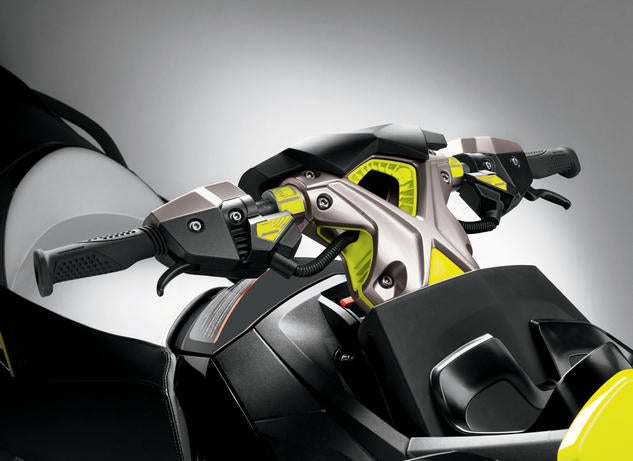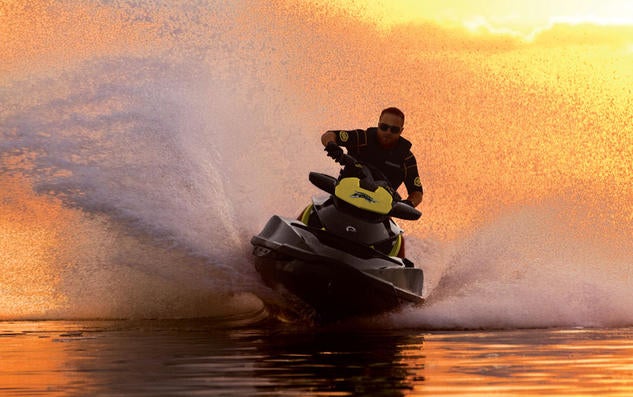2013 Sea-Doo RXT-X aS 260 Review
Sea-Doo's muscle craft king
Sea-Doo makes more than its share of performance-minded craft, but perhaps no model has more of a core focus than the RXT-X aS 260. A suspension-equipped muscle machine aimed at big-water, offshore types, it packs virtually all the tricks Sea-Doo has in its bag…and then some.
An Offshore Focus
Clearly the most interesting piece of the aS 260 puzzle is the craft’s suspension; a variation on Sea-Doo’s Intelligent Suspension concept. In essence, that system separates the boat into two primary pieces – a hull below which contacts the water, and the rider area above, including seat, handlebars, and footwells. The rider area is linked to the hull via pivoting arms fore and aft, with a centrally located coil spring and gas shock. Pound through some ocean waves and instead of taking the customary jolts the suspension allows the rider pod to move almost six inches to absorb shock. Less pounding means not only a more comfortable ride, but also less fatigue over long distances.
 A trick-looking adjustable shock allows users to fine-tune the suspension for the conditions.
A trick-looking adjustable shock allows users to fine-tune the suspension for the conditions.True performance types, however, desired more control over what Sea-Doo initially offered. Example? In offshore conditions, the stock suspension could bottom out. On the RXT-X aS 260, that lower-case “a” heralded the introduction of true adjustability for just these type of riders. Users could make the suspension softer or stiffer via a trick-looking nitrogen-charged remote oil reservoir visible in the glovebox. Turn the dial one direction and the suspension is stiffened out, great for those really big offshore conditions. Turn it the other and you can soften it up. Sea-Doo reveals the suspension is calibrated for 2’-5’ conditions, with the actual compression dampening about 65-115% greater than a RXT iS with the traditional suspension. The amount of suspension preload can also be increased if desired by turning an adjustment screw below the seat.
VIEW: Read our review of the Sea-Doo RXP-X 260
While the adjustable suspension is the most noticeable nod to offshore-type riding, there are other, more subtle features that enhance the user experience. Look under the bond line near the bow and you’ll notice sponsons, designed to eliminate the tendency of the bow to submarine into big waves. The sponsons are also said to improve steering response in rough water, as well as add some stability. Move to the opposite end of the hull and you’ll note trim tabs, which can be adjusted to user preference. Tabs increase the hull’s planing surface, most noticeably keeping the bow down for improved acceleration, but also enhancing the overall ride.
 Sponsons help keep the bow from diving into big waves and improve handling in rough water.
Sponsons help keep the bow from diving into big waves and improve handling in rough water.Below The Surface
While much of the exterior features are aimed at offshore performance, what lies within is just aimed at performance, period. It’s Sea-Doo’s familiar 1,494cc Rotax, equipped with a supercharger to ram in more air and an intercooler to cool and further condense that charge. As it does on Sea-Doo’s other top-end models, the engine pushes the boat quickly onto plane and progresses smoothly through the powerband en route to a top speed around 65 mph. As always, actual top speed depends on load, conditions, and rider skill. Under the right conditions, expect to push that number as high as 67, where it should be electronically limited.
 Sea-Doo’s supercharged, intercooled engine gets up to speed in a hurry.
Sea-Doo’s supercharged, intercooled engine gets up to speed in a hurry.Does the aS also perform on calm water? Of course. As the RXT-X namesake implies, this remains an aggressive, agile-handling machine, with a cornering ability that belies its substantial size. (How substantial? Try 139-plus inches and just shy of 1,000 pounds.) Suspension even aids in cornering, as the force of a hard turn literally compresses the suspension, pushing the driver closer to the hull to lower the overall center of gravity. As mentioned last year, the one notable tradeoff is the flip side of that equation at idle speeds, where a somewhat naturally higher center of gravity can make the craft feel tippy on occasion. The suspension design also limits that normally cavernous bow tub that PWC owners have become accustomed to, and as a result reduces storage capacity to only 16 gallons.
COMPETITION: Read our review of the Kawasaki Jet Ski Ultra 300X
Don’t Forget The Rest
With notable features like adjustable suspension, it’s easy to overlook other innovations that at one time thrilled, and now have become almost taken for granted. The first example is Intelligent Brake and Reverse, which uses a modified reverse bucket to give the boat stopping power at any speed, and also allows the craft to start in a neutral mode at the dock, and then be put into forward or reverse with ease…and with eyes remaining focused on the water. The latter is a fantastic addition around the dock or launch ramp. Intelligent Throttle Control also allows for the choice of different acceleration profiles – a tamer touring, the most aggressive sport, or an economy-minded ECO mode – to tailor the engine response to the needs of each ride or rider. A fast-responding variable trim can also adjust the craft’s attitude to enhance acceleration or top speed, or even keep that bow a little higher so that it doesn’t dive into the waves. Specific settings can be preset into the system, and then reached with a simple double-tap of the button, eliminating the need to take your eyes off the water.
 Not only are the handlebars the best looking ones in the industry, but they can also be adjusted for width and grip angle.
Not only are the handlebars the best looking ones in the industry, but they can also be adjusted for width and grip angle.And then there are the traditional “X” additions, including a racey-looking handlebar setup, which can be adjusted in width and grip angle, user-adjustable rear sponsons to quicken or soften the steering response, and a lower-profile seat that allows the driver to weight quickly and easily. The information display also gets some added performance-minded features, including a lap timer and average speed readout, along with distance and time-to-empty fuel reminders.
Is It For You?
Make no mistake, the aS 260 is obviously a niche craft, ideally designed for a certain type of hardcore, rough-water enthusiast. It’s these types who will most likely appreciate what it has to offer, and be willing to pay the price tag required to get it. That’s not as limited an audience as you might think. Offshore and long-distance endurance racing is increasing in popularity, and hence the need for boats that handle the conditions.
And then there are simply those who like the cushy ride, trick FOX-branded adjustable suspension, and power. You don’t have to use that suspension to its ultimate potential to enjoy the craft.
COMPETITION: Read our review of the Yamaha FZS
For the rest of us, the RXT-X aS 260 just may just be a really cool, trick watercraft that we only dream about. Whatever group you fall into, it’s a testament to Sea-Doo’s commitment to performance that such a craft was even put into production.
| 2013 Sea-Doo RXT-X aS 260 Specs | |
| Length | 139.2 inches |
| Beam | 48.2 inches |
| Curb Weight | 975 lbs |
| Engine | Three-cylinder EFI, supercharged/intercooled |
| Displacement | 1,494 cc |
| Bore and Stroke | 100 mm x 63.4 mm |
| Compression Ratio | 8.4:1 |
| Rated Horsepower | 260 |
| Fuel Capacity | 18.6 gal. |
| Combined Stowage Capacity | 16.4 gal. |
| Colors | Dayglow Yellow |
| Price | $16,399 |
Get PersonalWatercraft.com in your Inbox!
Like PersonalWatercraft.com on Facebook
Comments
Most Popular

Remembering the Sea-Doo XP

2025 Yamaha JetBlaster PRO 2-Up Review

2024 Yamaha GP HO Review

2024 Kawasaki Jet Ski STX 160X Review

2017 Kawasaki Jet Ski Ultra 310LX Review












 Your Privacy Choices
Your Privacy Choices